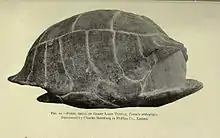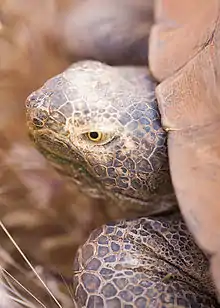Hesperotestudo
Hesperotestudo ("Western turtle") is an extinct genus of tortoise native to North and Central America from the Oligocene to the Late Pleistocene.[1][2][3][4][5] Species of Hesperotesudo varied widely in size, with the largest species reaching sizes comparable to extant giant tortoises, with carapaces over a metre (3.3 ft) in length. Historically considered a subgenus of Geochelone, it is now considered to be distantly related to that genus. Its closest relatives are the extant Gopherus (gopher tortoises) and the extinct Stylemys. The ancestor of the three genera arrived in North America during the Early Eocene.[6] The bodies of Hesperotesudo species were extensively covered with large dermal ossicles, which in life were covered in keratin. It has been suggested that species of Hesperotestudo were relatively tolerant of cold weather.[7] Hesperotestudo became extinct at the end of the Pleistocene and beginning of the Holocene co-incident with the arrival of the first humans in North America, and sites have been found where Hesperotestudo were butchered.[5]
| Hesperotestudo Temporal range: | |
|---|---|
 | |
| Hesperotestudo orthopygia | |
| Scientific classification | |
| Kingdom: | Animalia |
| Phylum: | Chordata |
| Class: | Reptilia |
| Order: | Testudines |
| Suborder: | Cryptodira |
| Superfamily: | Testudinoidea |
| Family: | Testudinidae |
| Genus: | †Hesperotestudo Williams, 1950 |
| Type species | |
| Hesperotestudo osborniana (Hay, 1904) | |
| Species | |
|
See text | |
Taxonomy
Species list is based on Vlachos, 2018[8]
- † Hesperotestudo Williams 1950[9]
- †Hesperotestudo bermudae Meylan and Sterrer 2000[1] Bermuda, Middle Pleistocene c. 310,000 years before present (YBP) - shell length c. 50 centimetres (1.6 ft)[5]
- †Hesperotestudo crassiscutata (Leidy 1889)[10] Florida, Texas, Illinois, South Carolina, Middle-Late Pleistocene shell length c. 120–125 centimetres (3.94–4.10 ft)[5]
- †Hesperotestudo ducateli (Collins and Lynn, 1936) Calvert Formation, Maryland, Middle Miocene (Langhian–Serravallian)
- †Hesperotestudo gilbertii (Hay, 1899) Ogallala Formation, Kansas, Hemphillian, Late Miocene-Early Pliocene (Tortonian–Zanclean)
- †Hesperotestudo orthopygia (Cope, 1878) (syn= Xerobates cyclopygius Cope, 1878 =Caryoderma snovianum Cope, 1886 = Testudo rexroadensis Oelrich, 1952 = Geochelone nordensis Holman, 1973) Kansas, California, Nebraska, Late Miocene-Pliocene shell length c. 120 centimetres (3.9 ft)[6]
- †Hesperotestudo osborniana (Hay, 1905)(syn= Testudo arenivaga Hay, 1906 = Testudo farri Hay, 1908 = Testudo impensa Hay, 1908 = Testudo orthopygia angusticeps Matthew, 1924) Colorado, Nebraska, Montana, Early Miocene-Early Pliocene shell length up to 92 centimetres (3.02 ft)
- †Hesperotestudo turgida (Cope, 1892) (syn = Testudo incisa Hay, 1916a = Testudo riggsi Hibbard, 1944 = Testudo wilsoni Milstead, 1956 = Geochelone johnstoni Auffenberg 1962 = Geochelone alleni Auffenberg, 1966 = Geochelone oelrichi Holman, 1972a = Geochelone mlynarskii Auffenberg, 1988) Florida, Oklahoma, Kansas, Texas, Nebraska, Late Miocene-Late Pleistocene shell length c. 22–25 centimetres (0.72–0.82 ft)
- †Hesperotestudo williamsi (Auffenberg, 1964) Oakville Formation, Texas, Early Miocene (Burdigalian) shell length c. 33.4 centimetres (1.10 ft)
References
- Meylan, P. A.; Sterrer, W. (January 2000). "Herperotestudo (Testudines: Testudinidae) from the Pleistocene of Bermuda, with comments on the phylogenetic position of the genus". Zoological Journal of the Linnean Society. 128 (1): 51–76. doi:10.1111/j.1096-3642.2000.tb00649.x.
- Olson, S. L.; Meylan, P. A. (December 2009). "A Second Specimen of the Pleistocene Bermuda Tortoise, Hesperotestudo bermudae Meylan and Sterrer". Chelonian Conservation and Biology. 8 (2): 211–212. doi:10.2744/CCB-0766.1. S2CID 85595118. Retrieved 2012-04-12.
- "White River Badlands: prospecting for ancient tortoise fossils". Florida Museum. 2004-10-01. Retrieved 2021-12-06.
- "Ashfall Animals | Ashfall Fossil Beds". ashfall.unl.edu. Retrieved 2021-12-06.
- Rhodin, A.G.J.; Thomson, S.; Georgalis, G.; Karl, H.-V.; Danilov, I.G.; Takahashi, A.; de la Fuente, M.S.; Bourque, J.R.; Delfino M.; Bour, R.; Iverson, J.B.; Shaffer, H.B.; van Dijk, P.P.; et al. (Turtle Extinctions Working Group) (2015). "Turtles and tortoises of the world during the rise and global spread of humanity: first checklist and review of extinct Pleistocene and Holocene chelonians" (PDF). Chelonian Research Monographs. 5 (8): 000e.1–66. doi:10.3854/crm.5.000e.fossil.checklist.v1.2015.
- Biewer, Jacob; Sankey, Julia; Hutchison, Howard; Garber, Dennis (2016-03-08). "A fossil giant tortoise from the Mehrten Formation of Northern California". PaleoBios. 33. doi:10.5070/p9331030312. ISSN 2373-8189.
- Moll, Don; Brown, Lauren E. (2017). "Reinterpretation of the Climatic Adaptation of Giant Fossil Tortoises in North America". Herpetological Journal. 27 (3): 276–286.
- Vlachos, Evangelos (2018-04-17). "A Review of the Fossil Record of North American Turtles of the Clade Pan-Testudinoidea". Bulletin of the Peabody Museum of Natural History. 59 (1): 3. doi:10.3374/014.059.0101. ISSN 0079-032X.
- Williams , E.E. 1950. Testudo cubensis and the evolution of Western Hemisphere tortoises. Bulletin of the American Museum of Natural History 95:1–36.
- Leidy, J. 1889. Description of vertebrate remains from Peace Creek, Florida. Transactions of the Wagner Free Institute of Science of Philadelphia 2:19–31.
